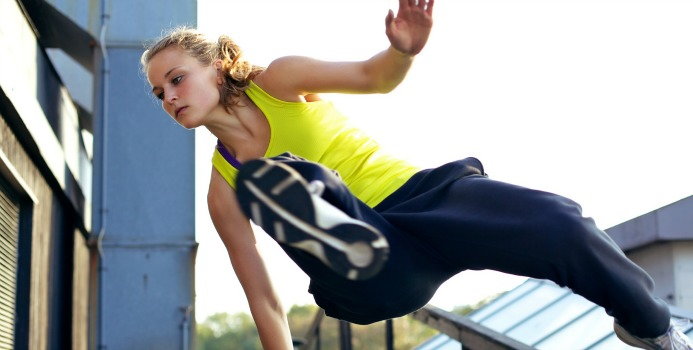Parkour is a highly demanding form of exercise, one that pushes your body to its limits of endurance and resistance. All the running, jumping, and climbing can take its toll on your muscles, bones, and joints. It's vital that you train your body in the gym as well as on the streets. You have to spend as much time doing regular resistance training as you do when you are practicing your parkour!
Here are a few parkour workout tips to help you out:
Focus on cardiovascular strength -- You're going to spend A LOT of time running and jumping, so you need to train your heart and lungs to keep up with the strain. Perform functional strength training movements like Burpees, Jumping Jacks, Box Jumps, and Squat Jumps to develop cardiovascular endurance as you build strength.
Build strong "pulling" muscles -- The best exercises to do in your parkour workout involve pulling motions: pull-ups, bicep curls, cable pulldowns, rows, etc. These exercises will develop your back, shoulders, and arms, the muscles that are most engaged during your parkour training sessions.
Balance your musculature -- While the "pulling" muscles are the most important for parkour, you can't neglect your "pushing" muscles (chest and triceps). If you do, you'll end up with imbalanced musculature, which can lead to musculoskeletal defects. You don't need to spend as much time working your chest and triceps, but don't skip them either.
Strengthen your legs -- Your legs are going to be doing most of the work while running, jumping, and climbing. Strong legs are a MUST for parkour. While you can strengthen your legs on your park days (the days you practice on the street), you should spend at least an hour a week training them in the gym. Focus on functional strength rather than sheer power.
Improve mobility -- All of the resistance training you do should help to increase mobility and flexibility as well as strength. Include plenty of multi-joint movements, and work the muscles from as many directions as possible. The more mobile and flexible you are, the less likely you are to be injured during your free running.
Run A LOT -- You should run at least 10 miles per week at the beginning of your training, and keep increasing your run time as you become more adept at parkour. The more you run, the easier it will be to keep up with the fast pace of your parkour.
Do other forms of exercise -- Don't just focus on your running, jumping, and climbing, but get involved with other forms of exercise: Yoga, boxing, swimming, martial arts, etc. These other types of exercise will help to increase your overall strength, endurance, and mobility across the board, instead of just concentrating on sport-specific conditioning. While it's vital that you spend plenty of time training for parkour specifically, you do need to mix things up to ensure your body can handle anything.
Stretch -- You should spend at least an hour every week stretching (break it up into shorter segments if you want, but do it!). The more flexible you are, the less likely you are to suffer injuries while free running.
Perfect your jumps -- A large part of your training needs to focus on your lower body, specifically your jumps. You not only need to develop explosive strength (for more power and distance in your jumps), but also improve your landing technique.
With these tips, you can get in the peak physical condition needed to be an expert at parkour!



